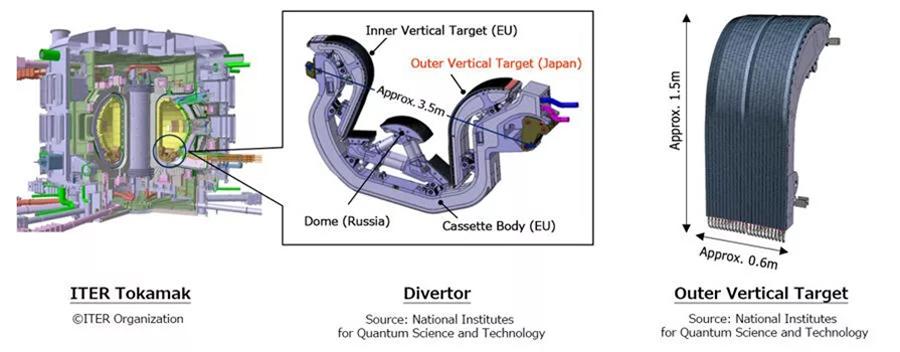Press Information
MHI Receives Order for Additional 12 Units of the Outer Vertical Target for the Divertor Used in the ITER in Southern France
・ Order for 12 units in addition to the six currently in production, giving MHI responsibility for production of units for 18 of the total 54 divertors
・ Manufacture and delivery of major components for ITER to contribute to the steady advancement of nuclear fusion development

Tokyo, May 20, 2024 - Mitsubishi Heavy Industries, Ltd. (MHI) has been awarded a contract from Japan's National Institutes for Quantum Science and Technology (QST) related to the ITER experimental fusion reactor(Note1),(Note2) currently under construction in southern France. The contract is for manufacture of 12 additional units of the Outer Vertical Target, a key component of the Divertor. MHI received this order in recognition of its accumulated technologies for mass production of components with a high degree of manufacturing difficulty, and follows the initial production order for manufacture of six units (Unit 1 - Unit 6) received in 2021.(Note3) With the additional 12 units (Unit 7 - Unit 18), MHI will handle manufacture for 18 of the total 54 units. Production of these units will be completed successively, with delivery to QST expected to begin in 2026.
The divertor is one of the most crucial components of the fusion reactor used in the tokamak. Its function is to discharge unburned fuel and impurities such as helium (He) in the core plasma generated by the fusion reaction, in order to stably confine the plasma.
The heat load on the divertor reaches a maximum of 20MW/m². This is equivalent to the surface thermal load on an asteroid probe during re-entry into the atmosphere, and approximately 30 times the surface thermal load on the Space Shuttle. Since the Outer Vertical Target, which directly faces the plasma due to its structure, is used in an extreme environment where it is exposed to the heat load and high energy particle loading from the plasma, and its structure has an extremely complex shape, high-precision fabrication and processing technology is required.
MHI has also received orders for production for five (of a total of 19) toroidal field (TF) coils, another core component of ITER, all of which were shipped by 2023.(Note4) Going forward, MHI will continue its efforts for manufacturing of major components such as the divertor and equatorial launcher.(Note5) In addition, MHI will actively support the design and development of the fusion prototype reactor planned to be constructed following the ITER project, contributing to the realization of fusion energy.
- 1Fusion is the energy source that enables the sun to keep shining. The ultimate goal is achieving fusion on Earth. Fusion reactions fuse light atomic nuclei (deuterium and tritium) in a plasma environment into the heavier element of helium. Fusion reactions emit zero carbon dioxide, and their source of fuel can be extracted from seawater in virtually unlimited quantities (lithium from which tritium is derived, and deuterium). Fusion energy is expected to provide fundamental solutions to many of the world’s energy and environmental problems.
- 2 The ITER Project is an international megaproject to demonstrate, both scientifically and technologically, the feasibility of fusion energy. Seven participating parties (Japan, the EU, the U.S., Russia, South Korea, China, and India) are constructing ITER in Saint-Paul-lès-Durance, France, with a target for full-fledged operational startup of nuclear fusion combustion by 2035. QST, as the ITER Japan domestic agency for the ITER Project designated by Japanese government, is in charge of procuring these components.
- 3For more information on the six units of divertor outer vertical targets that QST ordered from MHI in 2021, see the following press release.
https://www.mhi.com/news/211213.html - 4For more information on the TF coils that QST ordered from MHI, see the following press release.
https://www.mhi.com/news/210524.html - 5The equatorial launcher is a device to heat the plasma by injecting high-frequency beams.
About MHI Group
Mitsubishi Heavy Industries (MHI) Group is one of the world’s leading industrial groups, spanning energy, smart infrastructure, industrial machinery, aerospace and defense. MHI Group combines cutting-edge technology with deep experience to deliver innovative, integrated solutions that help to realize a carbon neutral world, improve the quality of life and ensure a safer world. For more information, please visit www.mhi.com or follow our insights and stories on spectra.mhi.com.





